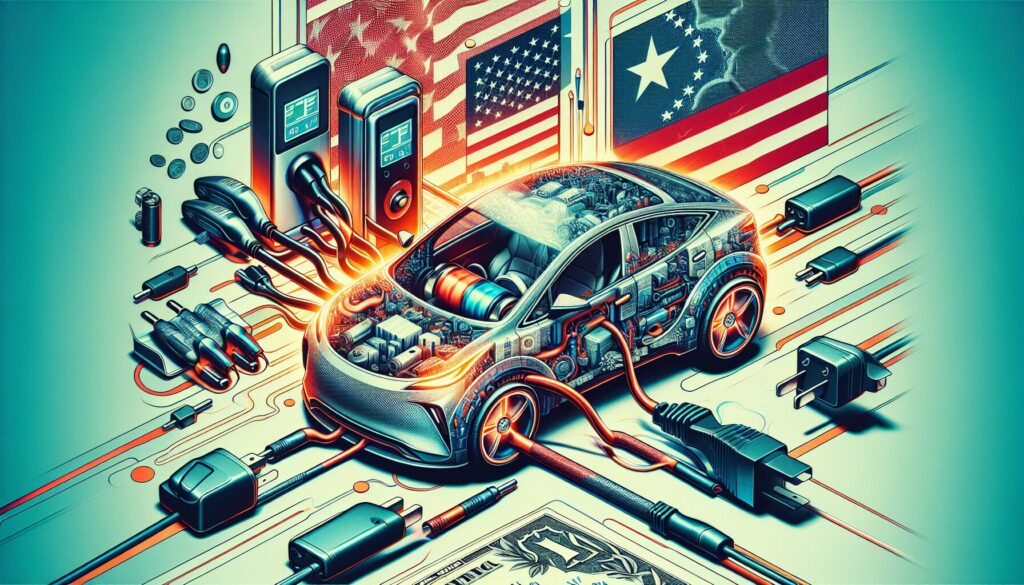Imagine cruising down the streets of Sydney, heading towards Bondi Beach, when your electric vehicle signals a low battery. Instead of waiting around for a charge, you pull into a battery-swapping station. In a matter of minutes, an automated system replaces your depleted battery with a fully charged one. This is the beauty of battery swapping! It feels almost futuristic, yet it’s happening right now. These stations use advanced automated robotics to ensure that the swap is both quick and efficient. They also employ sophisticated thermal management systems to keep batteries at optimal temperatures, extending their lifespan. Moreover, state of charge (SOC) optimization algorithms help to ensure that you’re getting the most from each swap. Companies like Better Place and NIO are leading the charge, making battery swapping an exciting and viable option for electric vehicle owners.
The Technology Behind Battery Swapping
When I first explored battery swapping technology, I was captivated by the combination of advanced systems working together. Imagine this: a vehicle rolls into a station, and you’ve got automated guided vehicle (AGV) systems maneuvering with precision. These systems, guided by the CAN bus communication protocol, ensure the efficient transfer of batteries. It’s like watching a well-choreographed dance, with every move calculated for optimum efficiency.
One weekend, I had a chat with a tech enthusiast at a local meetup in Sydney. We got into the nitty-gritty of Lithium iron phosphate (LFP) battery chemistry. These batteries are a game-changer for swapping stations. They offer a longer lifespan and enhanced safety, making them ideal for frequent swaps. Plus, the thermal management systems ensure that these batteries stay cool, even in our hot Aussie summers. This is crucial for maintaining performance and safety.
Key Components in Action
Several components make up the backbone of battery swapping technology:
- Automated robotics: These handle the heavy lifting, ensuring quick and accurate battery exchanges.
- SOC optimization algorithms: These smart algorithms manage energy levels, maximizing the potential of each battery.
- Thermal management systems: Critical for maintaining battery health, especially in varying temperatures.
Furthermore, organizations like Tesla and NIO are pushing the envelope with innovative battery swapping stations. Their systems promise rapid exchanges, aiming to make long charging waits a thing of the past. The future of transport down under is looking pretty exciting, don’t you think?
Advantages of Battery Swapping Over Charging

Battery swapping can be a game-changer, especially for those of us living in the sprawling landscapes of Australia. The convenience is hard to beat. Imagine driving through the stunning outback and realizing your battery’s running low. Instead of waiting at a charging station, you can simply swap out your depleted battery for a fully charged one. It’s like having an instant refill that gets you back on the road in no time!
One day, I was chatting with a friend who works on battery management systems (BMS) algorithms. He mentioned how these algorithms are optimized for quick energy transitions during swapping. This efficiency is due to the advanced state of charge (SOC) optimization algorithms. They ensure that each swap maximizes battery life and performance. It’s fascinating how technology can make our lives smoother and more efficient.
Key Benefits of Battery Swapping
There are several advantages to consider:
- Speed: Swapping a battery is often faster than traditional charging, which is perfect for busy commuters.
- Consistency: Swapping stations provide a fully charged battery every time, eliminating range anxiety.
- Infrastructure: Setting up swapping stations can sometimes be more cost-effective than building extensive charging networks.
Additionally, swapping stations don’t require the same high-power grid connections as fast chargers. This can be particularly beneficial in remote areas where infrastructure is limited. According to the International Energy Agency, energy demand for electric vehicles is expected to rise, making efficient solutions like swapping even more crucial.
Furthermore, companies like Tesla and NIO are already exploring battery swapping technology, showing its potential to revolutionize the EV industry. It’s exciting to see how battery swapping is paving the way for a more sustainable future. As more people adopt electric vehicles, the need for efficient and convenient solutions will only grow.
Challenges in Implementing Battery Swapping
Walking through the world of battery swapping, I’ve seen firsthand the challenges that come with implementing this technology. One of the biggest hurdles is ensuring the efficiency and longevity of the battery packs used in these systems. You see, the constant swapping can lead to uneven lithium-ion cell degradation rates, which is something that needs careful monitoring. The Battery Management System (BMS) plays a crucial role here, as it must be meticulously calibrated to track these changes and optimize performance. It’s a bit like tuning a musical instrument; if one string is off, it affects the entire melody.
Another challenge is the logistics of setting up swap stations. I once had a chat with a friend who works with Tesla about the intricacies of their setup. They shared that the use of Automated Guided Vehicles (AGVs) is crucial for handling the batteries. These AGVs are like the unsung heroes of the operation, moving heavy battery packs with precision. But their deployment requires significant investment and planning. The complexity increases when you consider the integration with CAN bus systems for real-time communication.
Environmental and Geographic Considerations
Down under here in Australia, other factors come into play. The vast distances between major cities make it a logistical puzzle. Plus, the unique climate presents specific thermal management challenges. Effective Electric car battery swapping technology requires robust thermal management systems to keep batteries from overheating in the extreme heat. It’s a bit like managing the air conditioning in your car on a scorching summer day—essential for smooth operation.
Moreover, local regulations can vary widely, adding another layer of complexity. The standards for electrical safety and environmental impact must be met, which often involves liaising with government bodies like Australian Energy Regulator. It’s a dynamic and ever-evolving landscape, but the potential benefits make it an exciting field to be in.
Case Studies: Successful Battery Swapping Models

Imagine this: a bustling warehouse in Brisbane, where Automated Guided Vehicles (AGVs) zip around like busy bees. They handle the heavy lifting but face one big challenge — efficient battery swapping. One brilliant solution came from a chat I had with an engineer from Fastcharge Australia. They implemented a cutting-edge system that combines thermal management and State of Charge (SOC) optimization algorithms. This allows AGVs to swap batteries swiftly and safely, keeping operations running smoothly.
Another fascinating model hails from Melbourne. The local logistics company, Green Logistics, adopted a system using the CAN bus. It seamlessly communicates between different parts of their battery management system (BMS). Their approach is all about maximizing the uptime of their fleet. They’ve reduced downtime significantly by ensuring that batteries are always at optimal temperatures. This is thanks to their advanced thermal management strategies.
Innovative Approaches in Sydney
Now, let’s head over to Sydney, where things get even more intriguing. A tech startup there has taken battery swapping to the next level. They’ve integrated Lithium Iron Phosphate (LFP) battery chemistry with intelligent SOC algorithms. This combo ensures a longer lifespan for each battery. Additionally, they use automated robotics to manage the swapping process, reducing human error and increasing overall efficiency.
These case studies show the creativity and innovation happening in Australia. By leveraging advanced technologies, these companies are setting new benchmarks in battery swapping efficiency. It’s exciting to see how these models are reshaping the future of logistics and transport. Each approach is unique, tailored to the specific needs and challenges of its environment. They all highlight the potential for even greater efficiencies in the future.
Future Prospects of Battery Swapping
Imagine this: you’re in the heart of Sydney, sipping on a flat white, and chatting with a mate who’s just back from a trip to Tesla. They’ve been raving about the advancements in battery swapping for electric vehicles. It got me thinking about how this technology could revolutionize our daily commutes. The potential is enormous, especially with the rise of Automated Guided Vehicles (AGVs) in logistics and transportation industries. These AGVs use BMS and SoC optimization algorithms to ensure they operate at peak efficiency, which is critical for maximizing productivity.
As we look to the future, the integration of power electronics thermal management systems will play a vital role in enhancing battery swapping. These systems are designed to regulate the temperature of the batteries efficiently, ensuring they don’t overheat during the swap process. This is particularly important in Australia’s diverse climate, where temperature variations can significantly impact battery performance.
The Role of Technology in Enhancing Efficiency
One exciting prospect is the development of more advanced Lithium Iron Phosphate (LFP) battery chemistry. This chemistry offers greater thermal stability and a longer lifespan, which could make battery swapping stations more sustainable and cost-effective. Imagine a network of swapping stations powered by these robust batteries, efficiently managed by state-of-the-art CAN bus systems. The future of battery swapping efficiency looks bright, promising quicker and more reliable energy solutions for electric vehicles.
Furthermore, companies like Better Place are exploring innovative ways to streamline the swapping process. By automating the exchange procedure and incorporating AI-driven SoC algorithms, they’re aiming to reduce wait times and enhance user experience. As these technologies evolve, we might soon see a day when pulling into a battery swapping station is as routine as filling up at a petrol pump.
Conclusion
Ultimately, battery swapping technology is poised to revolutionize the electric vehicle landscape by offering a faster, more efficient alternative to traditional charging methods. The combination of advanced robotics, thermal management systems, and state-of-the-art algorithms makes it a compelling solution, especially in geographically diverse regions like Australia. As more companies invest in and refine these systems, the future of transportation promises to be more sustainable, convenient, and exciting. Here’s to electrifying journeys ahead!
Continue Exploring
Ready to revolutionize your energy game? Dive into the future of sustainable power with battery swapping, the game-changer you've been waiting for!
Frequently Asked Questions
What are the key factors affecting the efficiency of battery swapping systems?
The efficiency of battery swapping systems is influenced by several factors including the design of the swapping infrastructure, the technology used in the battery and the vehicle, the speed of the swapping process, and the integration with energy management systems. Additionally, factors like the availability of standardized battery modules and the logistical aspects of maintaining a network of swapping stations also play crucial roles.
How does battery swapping compare to traditional charging methods in terms of efficiency?
Battery swapping can be more efficient than traditional charging methods as it significantly reduces downtime for electric vehicles. While traditional charging can take hours, swapping a depleted battery for a fully charged one can be completed in a matter of minutes. This not only increases the vehicle’s uptime but also helps manage energy loads more effectively across the grid by charging batteries during off-peak hours.
What technological advancements are enhancing the efficiency of battery swapping stations?
Recent technological advancements enhancing the efficiency of battery swapping stations include the development of automated swapping mechanisms, improved battery standardization, and integration with smart grid technologies. These advancements enable faster swaps, better energy management, and the ability to serve a broader range of electric vehicles, thereby improving overall operational efficiency.


Leave a Reply